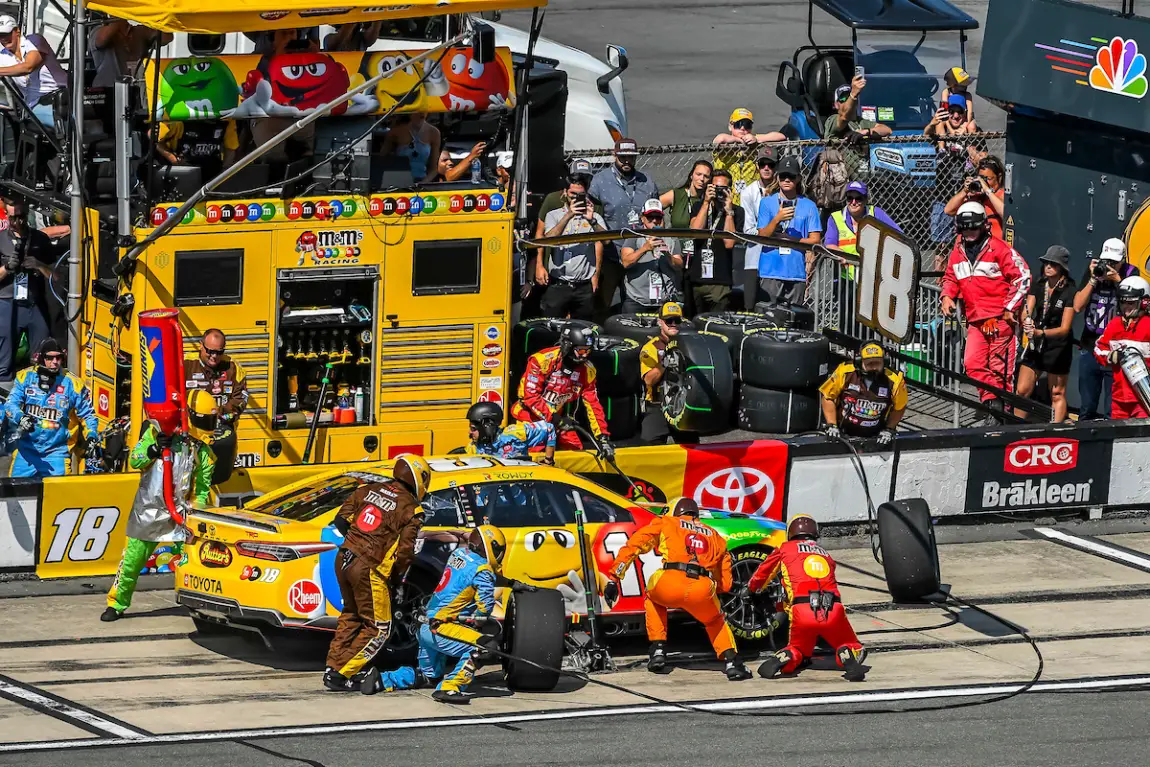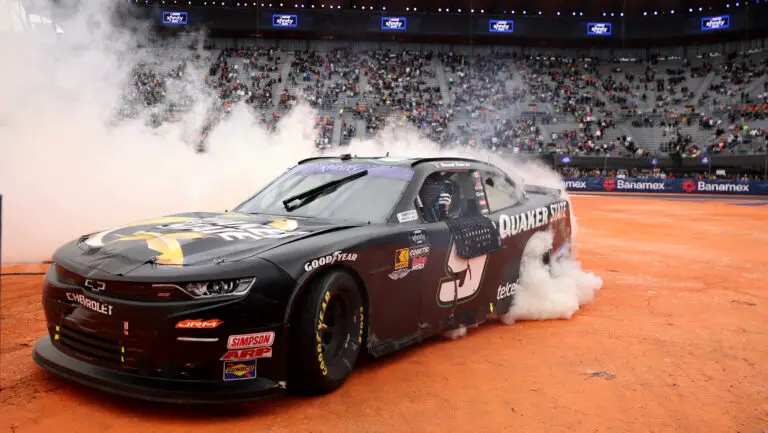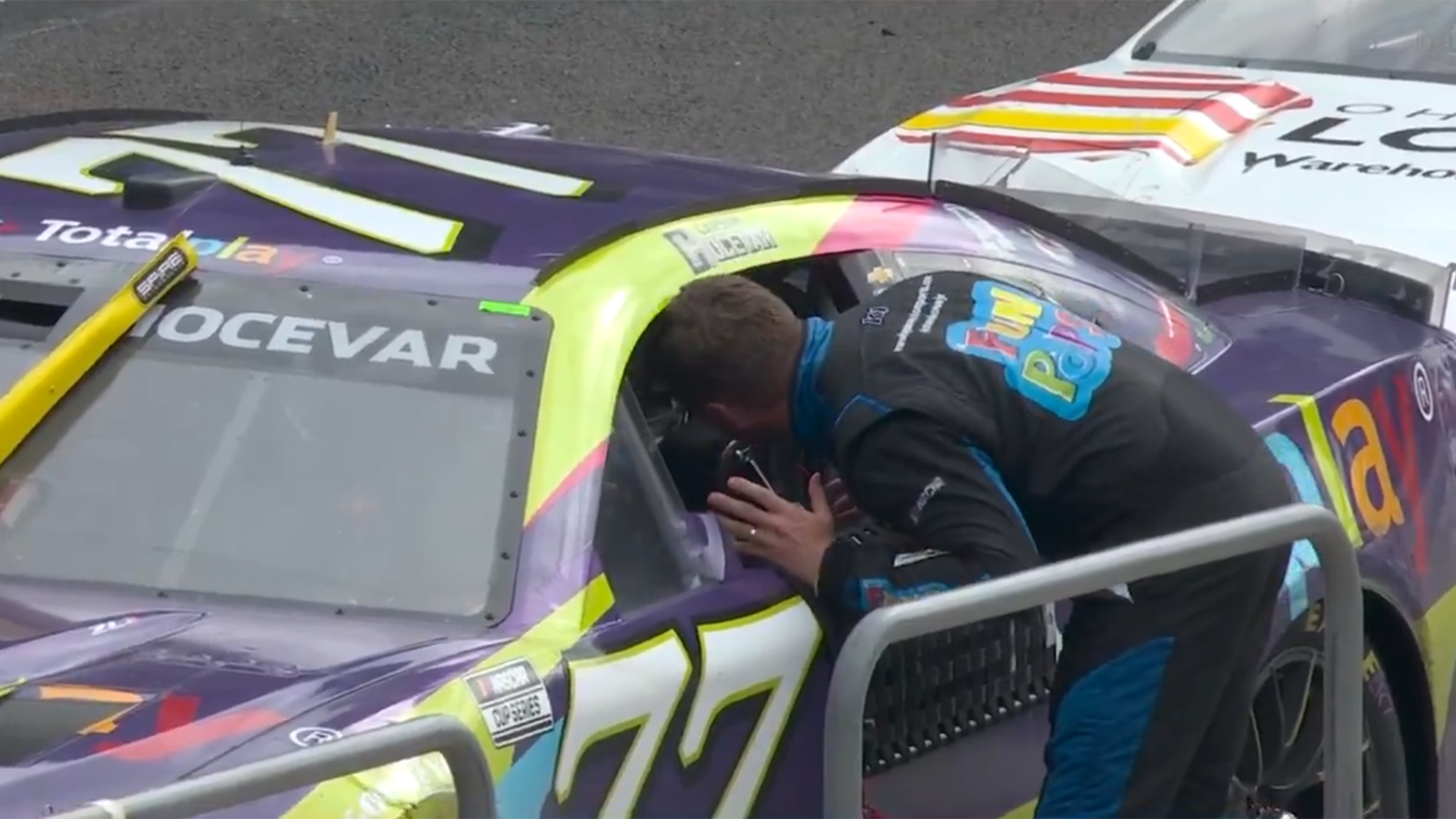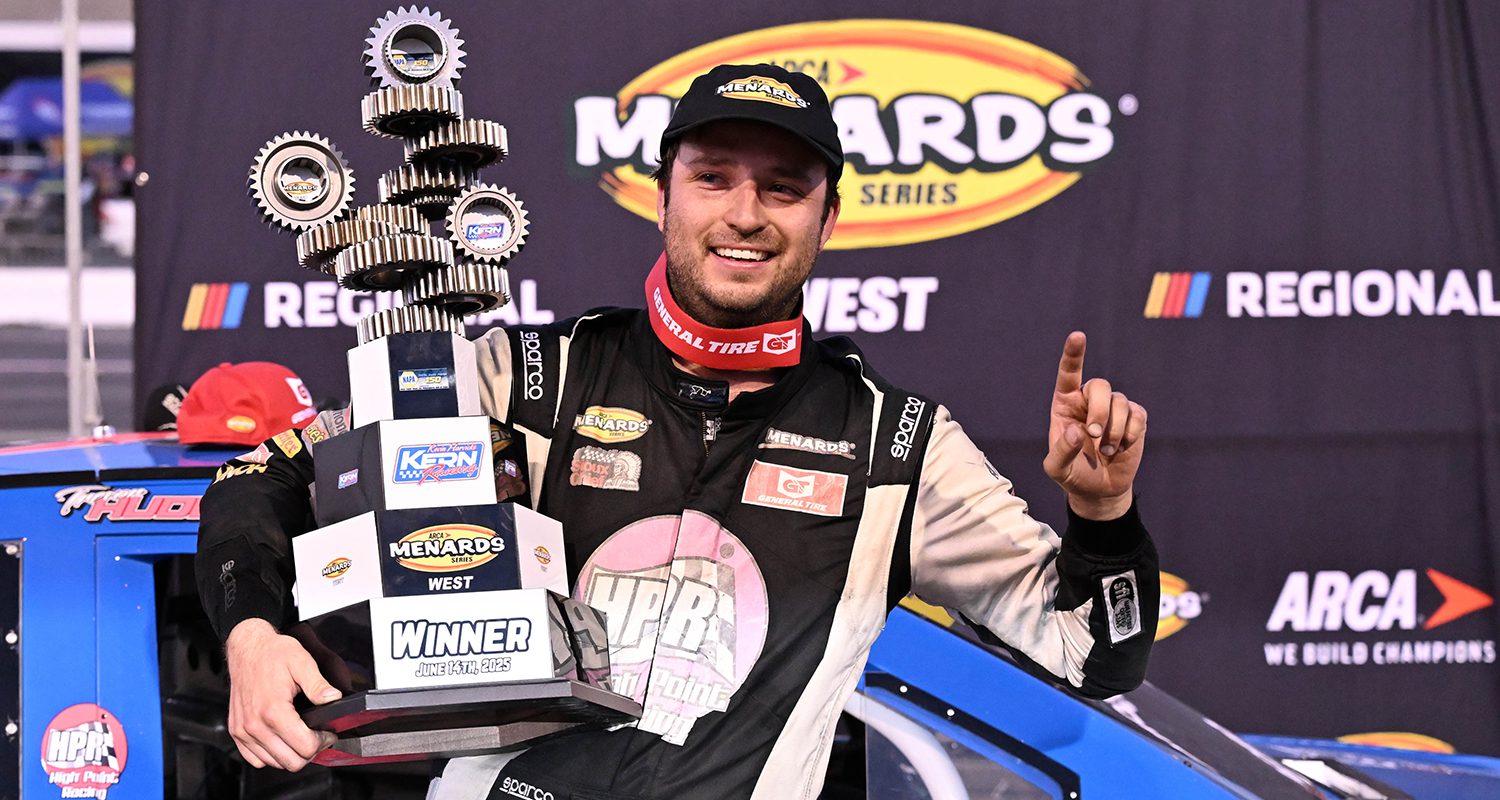
The NASCAR pit crew, they’re the true unsung heroes of the sport. With one simple mistake by the pit crew, a for sure win can evaporate in an instant. At the same token, an incredible stop at the opportune time can elevate a good day into being a great day for a driver.
However, much like linemen in the National Football League, you don’t hear much about the pit crew, unless something goes wrong in the race.
After a record-breaking 8.6-second pit stop performed by Kyle Busch’s No. 18 Joe Gibbs Racing team in this past Sunday’s NASCAR Cup Series Federated Auto Parts 400 at Richmond Raceway, it’s time to reverse that line of thinking.
The No. 18 pit crew at Richmond Raceway was made up of: Thomas Hatcher (Front Tire Changer), CJ Bailey (Tire Carrier), Lee Cunningham (Rear Tire Changer), Kellen Mills (Jack) and Matthew Tyrrell (Fueler). These folks deserve to be highlighted for their incredible achievement.
The 8.6-Second Four-Tire Pit Stop
For longtime fans of NASCAR, an 8.6-second four-tire pit stop would have seemed like a far-fetched idea prior to the 2022 season. But with the NASCAR Next Gen car, the impossible has officially become possible.
With single lug nut wheels, and teams attempting to maximize speed on pit road with brand new choreography, pit stop speed are increasingly becoming reliant upon the speed of gravity, which delivers fuel into the tanks of NASCAR Cup Series cars.
Sure, in the early parts of the season with the new car, teams struggled to get a handle on things. But now, as we are hurtling toward the Playoffs, teams, like Joe Gibbs Racing, are really starting to shave time off of pit stops.
On Wednesday, Joe Gibbs Racing shared overhead video of their record-breaking pit stop from Sunday’s race (click here to watch video).
According to Kellen Mills, the jack man on the No. 18 JGR team, the crew has a good idea whether the stop will be a good one or bad one, based on how the work on the right side of the car goes.
But the thing is, if the right side goes really well, the remainder of the pit stop becomes an intense and lightning-fast pressure cooker.
“It’s weird. We get so many practice stops, by the time you come off the right side, you already know if it’s got the potential already to be in that range,” Mills explained to TobyChristie.com. “A lot of the struggle of putting one of those stops together is, when you know it’s on pace to be fast, holding it together and finishing the stop. Maintaining your composure.”
As the team finishes a record-breaking stop, like the one Mills and the No. 18 team had on Sunday, they no longer immediately break into a celebration like pit crews have done for years with the previous models of NASCAR Cup Series car. Why? Because with so many variables that have to go right, such as every lug nut being tight, they want to make sure they were perfect before expressing elation of the speed of their stops.
“When the car is leaving — I mean this new pit stop and the speed that it is, it’s kind of hard for your mind to catch up with exactly what is going on,” Mills said. “You take two to three seconds to kind of look around and make sure that everybody else gives you the thumbs up that you didn’t put one thing out of order. Because you don’t want to celebrate then have a wheel come off or something horrific like that.”
Mills continued, “You almost second guess yourself. Like, man, that felt really fast. Let me get back to the computer and see exactly what we have.”
Brian Haaland, one of the Joe Gibbs Racing pit coaches, echoed Mills’ thoughts of the nervous moments following a fast pit stop with the new car.
“I was actually at the [Joe Gibbs Racing] shop in the war room [during the Richmond race]. We’ve got another coach that was traveling last weekend, but I had the same kind of delay. Like, is everything all good? It is! Good job, guys,” Haaland explained.
According to Haaland, who pushes all four of his teams to execute the fastest pit stops possible, he says not only did he expect an 8.6-second pit stop from JGR’s pit crews, he is actually astonished it hadn’t already happened before Richmond.
“100%,” Haaland said when asked if 8.6 seconds was expected. “I am more shocked that it took this long for it to happen. We actually started calling it the unicorn stop, because it’s often talked about, rarely seen, especially at the race track. But these guys, week-in and week-out, they show what they’re capable of here at the shop. They’re running low eight-second pit stops regularly in practice. So, it was a matter of time of it lining up at the racetrack.”
How Did We Get to Sub-Nine-Second Pit Stops?
So, how did we get here? Since the season began, we have seen sub 10-second stops, but now we are in unchartered territory, the sub-nine second pit stop.
For Mills, it’s the culmination of a lot of hard work that has led to the new record-breaking pit speeds we are seeing.
“I would say it falls into two categories. Obviously, the stop has gotten faster. It requires you to get from one position to another, with less time to think about it. So, there’s definitely a physical component to it. Which took a little bit of training,” Mills explained.
Once the physicality of the new style of pit stop was learned, teams then began to assess the risk and reward associated with different types of choreography and methods of which to complete the pit stops.
“The other side of it is the mental side. I’d even say with the choreography change that we decided to go with, there was risk and rewards and there wasn’t really any guarantees,” Mills said. “There was a lot of unknown unknowns that we didn’t quite know what we were getting ourselves into. We have enough practice time, where we can polish it as much as possible. But I mean, anyone who has been watching the races knows there have been a decent amount of cars leaving the box without tight wheels.
“You can have a lot of really great practices, but when you know the consequences are so high at the racetrack — you are benefitted by being very fast and taking risks, but when the consequences are so high you have to kind of individually as a pit crew and even as a crew chief kind of come up with a decision of how risky do we want to be? Because we do want to be fast, but we don’t want to take the race out of the driver’s or engineer’s hands.”
When it comes to wheels sliding off due to a loose lug nut, Haaland explains that it just showcases the razor-thin edge of being fast on pit road and attempting to be too fast on pit road.
“I think the big thing with [the loose wheels] is, that it just goes to show you the fine line that all of these pit crews are walking right now,” Haaland stated. “Because you’re walking that tight rope that is a successful pit stop, or a big time failure that costs a suspension of four weeks for the crew chief, tire changer and jack man. And it’s just like no other thing that we’ve experienced in this sport. You really had to have a bad mistake to have a wheel fall off with five lug pit stops.”
While fans only see pit crews fire over the wall on Sundays, Mills, the rest of the No. 18 JGR pit crew, and essentially every pit crew in the NASCAR Cup Series puts in hours upon hours during the week to hone their craft in order to potentially set themselves up for success in the race.
And when we say hours-upon-hours, we mean hours-upon-hours. Mills estimates that the JGR crews spend six to seven hours every week practicing live-action pit stops at their campus.
Additionally, Mills says crew members can reach 30 hours on the clock working on their craft, before you account for their time at the actual track on the weekend, as well as time pumping iron in the weight room.
But overall, the amount of hours the athletes on pit road put on their bodies is a true balancing act.
“It really kind of ranges, and you really have to factor that in over a season,” Mills said. “If you are going all the way in to where your body isn’t recovering — the movements that we do are so repetitive that it kind of pulls your body out of balance. So, you have to watch that. Especially the guys that have been pitting cars for a really long time. Each position has about one or two injuries that you can really see coming.”
On Pit Road, Injuries Are a Real — and Expected — Thing
The No. 18 team knows first hand from experience this season that injuries do indeed occur on pit road. In fact, an injury to rear tire changer Lee Cunningham in the moments before the Coca-Cola 600 in May, led to an uncertain situation for the team.
Cunningham was getting prepared for the race on Sunday afternoon, when an air bottle cart broke and caught his hand on the way down. The end result? A broken middle finger and ring finger on his left hand. The 35-year old tire changer went on to pit the entire race with busted and bloodied and gauzed fingers.
“It was the Coke 600, the longest race of the year. It was a huge race. We had that race circled. The fact that he broke his fingers so shortly before the race, we’re heading in to get our fire-suits on and then all of a sudden he’s in the infield care center getting his fingers taking care of. It was a huge question mark,” Mills recalled.
Cunningham’s injury led to Mills being on high alert for the entirety of the race, as he wasn’t sure how effective Cunningham would be with two broken digits, and with choreography at an all-time level of importance for the pit crew, it led to a nervous day and night for Mills.
“I’d say we were getting to a point in the season, where we were starting to get a feel for each other,” Mills said. “The way we do our choreography, the wheels that Lee is in charge of are the wheels that I’m not hanging tires on, so my back is always to Lee. So, whenever I’m dropping the jack, there’s almost a sixth sense between where he’s at and what’s going on and me just recognizing that things are where they’re supposed to be.
“I was very nervous before the race, because I was like, I’m going to have to really pay attention to Lee. Where I almost kind of don’t. He’s so consistent, he and CJ have a really good thing going back there, where I can just roll. I was like, man, I have to remember to check off on Lee on both corners, every side.”
To Mills’ surprise, Cunningham didn’t miss a beat.
“He was just as fast. I was like, man, if anything happens or grabs wrong and he jams one of those fingers, it’s going to slow things down and if I’m not ready for it, it could really blow a stop up,” Mills explained. “He was really tore up, and it was maybe one of the most impressive things I’ve ever seen. What kind of race he put together considering the situation he was in.”
Haaland agreed about the gutsy performance from Cunningham.
“I come from a hockey background, and hockey players are known to be tough, right? After the race, I went up to Lee and I said, ‘That is the most hockey player type performance I have ever seen and I’ll never forget it.’ His fingers were pretty mangled,” Haaland said.
While Cunningham hung in there, and the No. 18 team scored a runner-up finish in the race, as a result, the limitations of the team rosters since the COVID-19 pandemic really tested the team at the Coca-Cola 600.
“Since we were here in Charlotte, our front changer Thomas Hatcher, his wife Heather was there and right when it happened, she was on top of everything. Like when the stop was over, we’d get everything all cleaned up and ready and she had ice, Advil, clean gauze or whatever you needed. She really kind of stepped in,” Mills called back. “Our trainers used to travel, but when they shortened the roster lists they’re not necessarily able to be there. Luckily, we had Heather there to pick up the slack, that was a big help.”
Not only did the team not have trainers on site to bring aid to Cunningham, but the reduction of the size of team rosters led the team to think about putting their pit coach in at tire changer before it was determined Cunningham could gut it out.
“That’s another big thing also, with the shortening of the rosters is that we don’t have a backup tire changer available for an injury that happens an hour before the race, either. At one point, I was going to change tires, which that would have been — I don’t think we would have had the same outcome that night,” Haaland quipped. “It really puts you in a tight box of who is available and trying to get the job done.”
While Cunningham’s injury at Charlotte Motor Speedway was more of a freak accident, Mills says that the action on pit road can lead to aches and pains that can really turn troublesome as the 38-week NASCAR Cup Series season rolls on.
“I will tell you, it’s definitely a lot better than football. You get done with a football game, you have taken some wear and tear and you can feel where you got hit and that kind of thing,” Mills said. “I would say mostly pit stops, they kind of sneak up on you. You have something that just doesn’t feel right. You’ll push through it and it still doesn’t feel right. Then you’ll find yourself a month or two down the road and that little ache and pain has turned into a real issue.”
Mills credits the JGR athletic trainers for being the best training staff he has ever worked with over the course of his NASCAR career.
“I will say of all the teams I have ever been with, the training staff that we have here at Joe Gibbs Racing, the people that help kind of stay on top of us, the athletic training staff we have, do a phenomenal job. And in a huge way that helps us be more aggressive because whenever something gets out of whack, you know you have someone that has the expertise to reel you back in. Or again, give the professional opinion that you do need to get some rest.”
Haaland says the pit coaches training staff truly understand the stresses that go onto the body of the athletes on pit road.
“We’ve tested the limits of these guys, these athlete’s bodies,” Haaland said. “We have a good understanding with the coaching experience we have in the sport. We understand how long the season is. We know when to push. We know when to pull back. We know when recovery is going to be more beneficial than practice. It truly is a professional sport, and we treat it that way and I think you’re starting to see that on Sundays.”
Where Do We Go From Here? How Fast Can a Pit Stop Actually Be?
While the No. 18 team has become the standard-bearer for record-breaking pit times so far in 2022, Joe Gibbs Racing’s No. 11 team was actually on pace to out-do the No. 18 team’s 8.6-second stop at Richmond, until an error on the left front slowed the team down, and more than likely ended Hamlin’s bid at a win.
“They have definitely set the bar for our organization, as far as speed at the track,” Haaland said of the No. 18 team. “I think the scary thing for the other organizations out there, is that we have the same speed within the No. 11, 19 and 20.
“I am sure everybody saw the stop on the No. 11, that basically cost Denny a chance to win. The left front didn’t get changed because of an error, but they finished on the left rear at 8.3. So, they were getting ready to set a record of their own.
“But again, it’s that fine line. A little mistake cost them four seconds, as opposed to a mid eight-second pit stop. It’s a fine line, and we’ll continue to learn about it, but ultimately Joe Gibbs Racing wants fast pit stops for our drivers to have a better chance to win.”
So, the No. 18 team cranked out an 8.6-second stop, the No. 11 team was on pace for an 8.3-second stop… How much faster can a pit stop get? Mills says that is to be determined, as the No. 18 team pushes itself based on what other teams bring to the track.
“On my end, we jumped into this season kind of unsure of where we would be. Obviously, the more risk you take, the faster you will be,” Mills explained. “We didn’t know where our competition would essentially land, and from my perspective, our competition ended up being comfortable taking more risk than I assumed they would.
“We had a gap that we thought we were going to have, and it was smaller than anticipated because of the risks that people are willing to take. I think going forward, we know what our absolute top end is. The question is: If we have a little bit of a gap or competitive advantage over the rest of the competition, how much further do you want to push?”
While Mills has a conservative mindset, Haaland is full-on-press
“I think I’m a little more optimistic than Kellen is,” Haaland joked.
Which led to Mills pointing back, “Well you don’t get suspended four weeks when things go bad.”
“No but I hear about it on Monday,” Haaland chuckled. “I think they’ve set the bar and now we know it’s possible and now it’s going to be expected. Not just from the No. 18 car, but our other three cars also. And it put everyone on notice. Every single pit crew in the sport right now understands how fast the No. 18 team is capable of going and they’re trying to find those tenths of a second to dip into the eight-second range now. It’s what we live for, the competition side of the pit crews.”
Haaland continued by giving what he feels the optimal pit stop time is with the Next Gen car.
“We’ve got a theoretical time of 7.3, so, we’ll see if we can ever connect those dots and make it happen,” Haaland said.
While Haaland is dreaming of a sub-eight second pit stop, Mills just wants to savor what they have for now.
“Brian is more excited about it and it freaking stresses me out,” Mills joked. “Like, man, seven? Let’s just sit here and celebrate what we’ve got going for a bit and see if we can repeat it a few times before we start reaching for the sevens.”
Whether we ever see a sub-eight second pit stop or not, it’s just icing on the cake. Because I don’t think anyone expected to see an 8.6-second pitstop this year, or ever, in the NASCAR Cup Series.













